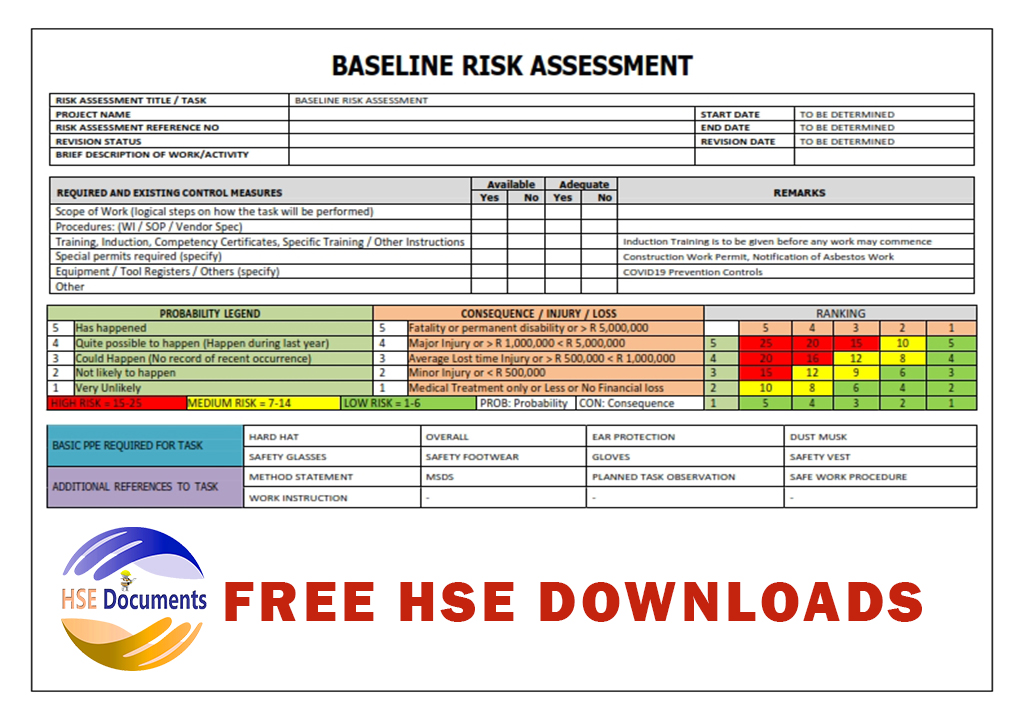WHAT IS BASELINE RISK ASSESSMENT?
Baseline risk assessment refers to the initial evaluation and analysis of potential risks and hazards associated with a specific project, activity, or system. It is typically conducted at the beginning of a project or when implementing a new process to establish a benchmark or starting point for risk management.
The purpose of a baseline risk assessment is to identify and understand the potential risks and hazards that could impact the project or activity. It involves gathering information, assessing the likelihood and severity of risks, and evaluating the existing controls and mitigation measures in place. The assessment helps in setting the foundation for risk management strategies and developing appropriate risk mitigation plans.
During a baseline risk assessment, the following steps are typically followed:
Hazard identification: Identify and document all potential hazards that could pose risks to the project, activity, or system. This involves considering various aspects such as equipment, processes, materials, environment, and human factors.
Risk assessment: Assess the identified hazards by evaluating their likelihood and potential consequences. This step involves analyzing the probability of occurrence and the severity of impact for each risk.
Risk prioritization: Prioritize risks based on their severity and likelihood, focusing on those with the highest potential impact. This helps allocate resources and prioritize risk management efforts effectively.
Existing controls evaluation: Evaluate the existing controls and mitigation measures in place to manage the identified risks. This involves assessing their adequacy, effectiveness, and compliance with relevant regulations or standards.
Risk mitigation planning: Develop a risk mitigation plan that outlines specific measures to reduce or eliminate the identified risks. This may involve implementing additional controls, improving existing processes, providing training, or considering alternative approaches.
Documentation and communication: Document the findings of the baseline risk assessment, including identified hazards, risk assessment results, and risk mitigation plans. Communicate this information to relevant stakeholders, including project teams, management, and regulatory authorities, as appropriate.
It is important to note that a baseline risk assessment is not a one-time activity. Risks and hazards should be continuously monitored and reassessed throughout the project lifecycle or as conditions change, allowing for ongoing risk management and the implementation of necessary adjustments to maintain an acceptable level of risk.
WHY IS BASELINE RISK ASSESSMENT IMPORTANT?
Baseline risk assessment is important for several reasons:
Identifying potential risks: By conducting a baseline risk assessment, organizations can systematically identify and recognize potential risks and hazards associated with a project, activity, or system. This helps in understanding the scope and nature of the risks involved, which is crucial for effective risk management.
Establishing a benchmark: Baseline risk assessment provides a starting point or benchmark against which future risk assessments can be compared. It sets the foundation for measuring the effectiveness of risk management efforts and determining the progress made in reducing risks over time.
Prioritizing risks: Through the assessment process, risks can be evaluated and prioritized based on their likelihood and potential impact. This allows organizations to focus their resources and attention on managing the most critical and high-risk areas, ensuring that efforts are appropriately directed.
Developing risk mitigation strategies: Baseline risk assessments help in the development of risk mitigation strategies and plans. By understanding the specific risks and their characteristics, organizations can devise appropriate measures to prevent, reduce, or manage those risks effectively. This enhances the organization's ability to implement targeted controls and responses to mitigate potential harm.
Compliance with regulations and standards: Many industries and jurisdictions require organizations to conduct baseline risk assessments as part of regulatory compliance. It ensures that organizations meet the necessary legal and industry-specific obligations, enhancing safety, and reducing the potential for accidents, incidents, or legal liabilities.
Decision-making and resource allocation: Baseline risk assessments provide valuable information for decision-making processes and resource allocation. By having a comprehensive understanding of the risks involved, organizations can make informed decisions about project planning, resource allocation, risk mitigation strategies, and overall risk management priorities.
Stakeholder communication and transparency: Baseline risk assessments provide a means of communicating risk information to relevant stakeholders, including project teams, management, employees, regulators, and the public. It promotes transparency, allows for informed discussions, and ensures that all stakeholders are aware of the potential risks and the measures in place to manage them.
Overall, baseline risk assessment plays a crucial role in proactively managing risks, preventing accidents and incidents, complying with regulations, and ensuring the safety and well-being of individuals, assets, and the environment. It helps organizations establish a strong risk management framework from the outset and provides a basis for ongoing risk monitoring and control.







1.jpg)


No comments:
Post a Comment